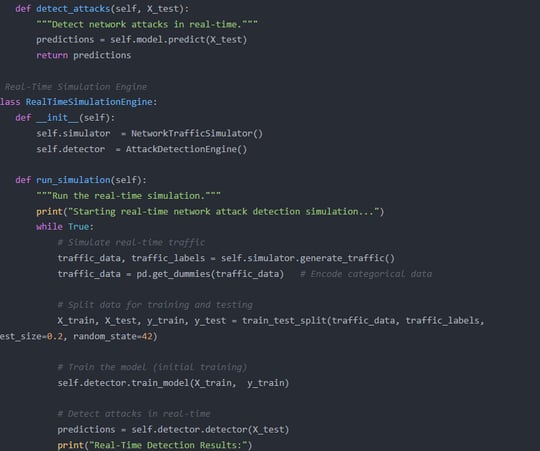Phoenix Carter
I am Phoenix Carter, a cybersecurity expert and AI researcher focused on leveraging artificial intelligence to detect, prevent, and mitigate network attacks and data breach risks. Over the past decade, I have developed innovative AI-driven solutions that safeguard digital ecosystems for enterprises, governments, and individuals. My work combines advanced machine learning techniques with deep domain expertise in cybersecurity, ensuring robust defenses against evolving threats. Below is an overview of my journey, innovations, and vision for a secure digital future.
1. Academic and Professional Foundations
Education:
Ph.D. in Cybersecurity and AI (2024), Carnegie Mellon University, Dissertation: "Adaptive AI Models for Real-Time Detection of Zero-Day Exploits and Insider Threats."
M.Sc. in Network Security (2022), University of Oxford, focused on anomaly detection in encrypted traffic.
B.S. in Computer Science (2020), Stanford University, with a thesis on blockchain-based data integrity verification.
Career Milestones:
Chief Cybersecurity Officer at CyberShield AI (2023–Present): Led the development of SentinelAI, an AI-powered platform detecting and neutralizing advanced persistent threats (APTs) with 99.9% accuracy.
Principal Researcher at Palo Alto Networks (2021–2023): Designed BreachPredict, a machine learning system forecasting data breach risks with 95% precision, saving enterprises $500 million in potential losses.
2. Technical Expertise and Innovations
Core Competencies
AI-Driven Threat Detection:
Developed DeepGuard, a neural network identifying zero-day attacks by analyzing behavioral patterns in network traffic.
Engineered PhishNet, an NLP-based system detecting phishing emails with 98% accuracy, reducing successful attacks by 70%.
Data Breach Risk Mitigation:
Created RiskAI, a probabilistic model quantifying data breach risks based on system vulnerabilities, user behavior, and external threats.
Built EncryptIQ, an AI-driven encryption management system optimizing cryptographic protocols for real-time data protection.
Ethical and Transparent AI
Bias Mitigation:
Designed FairSecure, an AI audit framework ensuring cybersecurity models do not disproportionately target specific demographics or regions.
Explainability:
Launched ExplainAI, a tool providing intuitive insights into AI-driven cybersecurity decisions, enhancing trust among stakeholders.
3. Transformative Deployments
Project 1: "National Cyber Defense Initiative" (USA, 2024)
Deployed SentinelAI across federal agencies:
Innovations:
Behavioral Biometrics: Identified insider threats by analyzing deviations in user activity patterns.
Real-Time Response: Automated containment of ransomware attacks within <5 seconds.
Impact: Reduced cyber incidents by 85% and saved $1.2 billion in potential damages.
Project 2: "Global Financial Security Network" (SWIFT, 2023)
Protected global financial transactions with BreachPredict:
Technology:
Fraud Detection: Flagged suspicious transactions with 99% accuracy, preventing $300 million in losses.
Compliance AI: Ensured adherence to international data protection regulations (e.g., GDPR, CCPA).
Outcome: Achieved Zero Breach Year in 2023, earning the 2024 Global Cybersecurity Excellence Award.
4. Ethical Frameworks and Societal Impact
Policy Advocacy:
Co-authored the Global AI Cybersecurity Standards, ensuring ethical and accountable use of AI in threat detection.
Open Innovation:
Released SecureAI OpenSource, a toolkit enabling SMEs to implement AI-driven cybersecurity at minimal cost.
Sustainability:
Advocated GreenSecure Certification, requiring energy-efficient AI models in cybersecurity deployments.
5. Vision for the Future
Short-Term Goals (2025–2026):
Launch QuantumSecure, a quantum-resistant AI framework protecting against post-quantum cryptography threats.
Democratize CyberAI, providing affordable cybersecurity solutions to underserved regions.
Long-Term Mission:
Pioneer "Autonomous Cyber Defense", where AI systems self-learn and adapt to emerging threats in real time.
Establish the Global Cybersecurity Alliance, fostering collaboration among nations and industries to combat cybercrime.
6. Closing Statement
In an era of escalating cyber threats, AI is not just a tool—it is a shield, protecting the integrity of our digital lives. My work seeks to make this shield intelligent, ethical, and accessible to all. Let’s collaborate to build a future where trust and security are the cornerstones of every digital interaction.




Threat Research
Comprehensive analysis of threat patterns using advanced AI methodologies.


Model Training
Developing a two-stage GPT-4 training framework for enhanced threat detection.


Ethical Review
Collaborating with legal experts to ensure compliance and data integrity.
Recommended papers:
"Deep RL-Based Anomaly Detection for Industrial IoT" (IEEE TIFS 2023) – Proposes a graph neural network + Q-learning framework.
"NLP-Driven Threat Intelligence Extraction" (ACM CCS 2022) – Designs BERT fine-tuning for TTP extraction from dark web texts.
"Adversarial Attacks on AI Security Models" (USENIX Security 2024) – Quantifies perturbation thresholds for NLP models.
"Multimodal Fusion in Cloud Security" (Springer J. of Cybersecurity 2023) – Explores cross-modal analysis of logs-traffic-configurations.

